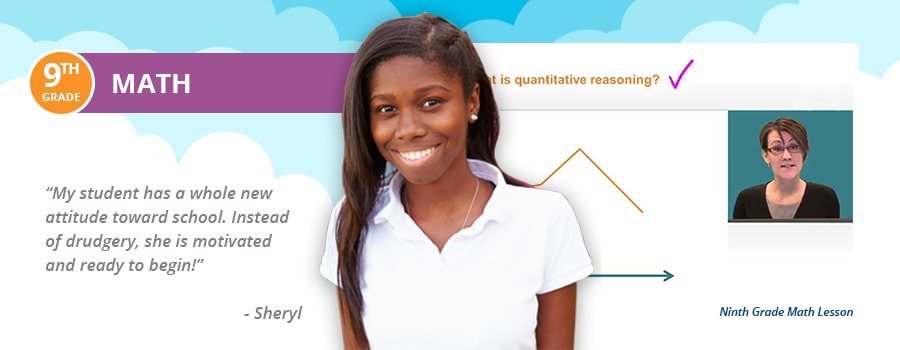9th Grade Math Curriculum
9th grade math usually focuses on Algebra I, but can include other advanced mathematics such as Geometry, Algebra II, Pre-Calculus or Trigonometry. This is the year when they formalize and extend their understanding and application of quadratic and exponential functions as well as other advanced mathematical concepts.
Ninth graders must fully understand concepts before moving on, or they will soon find themselves lost and confused. Learn how to help your child achieve academic success in mathematics with the information below.
What Math Should a 9th Grader Know
If your student hasn’t yet studied Pre-Algebra, that course should be their starting point. However, if they have already passed Pre-Algebra, you should start with Algebra 1 or Geometry interchangeably for your student. At that point, it is a matter of preference and your student’s individual aptitude.
The ideal ninth grade math curriculum will offer students the opportunity to practice and expand on the skills learned in middle school. In essence, at the beginning of the year a 9th grade math student should be able to:
- Demonstrate above average math fact fluency.
- Investigate and solve a number of problems using the Pythagorean theorem.
- Use reasoning skills to solve multi-step problems with rational and irrational numbers.
- Rearrange and solve basic algebraic equations.
Learn more about Time4Learning’s ninth grade math curriculum by checking out the 9th grade math lesson plans below.
Math Objectives for 9th Grade
Once you choose your ideal 9th grade math curriculum, make sure to set some attainable goals. These should include:
- Increase ability to solve algebraic expressions involving radicals and polynomials.
- Develop fluency in writing and solving multi-variable equations and inequalities.
- Gain understanding of nonlinear functions, including exponential and quadratic functions.
- Boost data analysis skills through various displays of data including box plots, regression models and more.
- Attain a high level of success in solving multiple algebraic expressions, and multi-dimensional figures.
- Getting a good understanding of budgeting, investing, and basic concepts of statistics.
Time4Learning’s 9th Grade Math Scope & Sequence
- Quantitative Reasoning
- Dimensional Analysis
- Writing and Solving Equations in Two Variables
- Writing and Graphing Equations in Two Variables
- Introduction to Functions
- Function Notation
- Evaluating Functions
- Analyzing Graphs
- Analyzing Tables
- Recognizing Patterns
- Introduction to Linear Functions
- Slope of a Line
- Slope-Intercept Form of a Line
- Point-Slope Form of a Line
- Writing Linear Equations
- Special Linear Relations
- Solving Linear Equations: Variable on One Side
- Solving Linear Equations: Variables on Both Sides
- Solving Linear Equations: Distributive Property
- Solving Mixture Problems
- Solving Rate Problems
- Literal Equations
- Solving Absolute Value Equations
- Solving One-Variable Inequalities
- Introduction to Compound Inequalities
- Solving Systems of Linear Equations: Graphing
- Solving Systems of Linear Equations: Substitution
- Solving Systems: Introduction to Linear Combinations
- Solving Systems of Linear Equations: Linear Combinations
- Modeling with Systems of Linear Equations
- Graphing Two-Variable Linear Inequalities
- Modeling with Two-Variable Linear Inequalities
- Solving Systems of Linear Inequalities
- Modeling with Systems of Linear Inequalities
- Linear Piecewise Defined Functions
- Step Functions
- Absolute Value Functions and Translations
- Reflections and Dilations of Absolute Value Functions
- The Square Root Function
- The Cube Root Function
- Performance Task: Construct and Analyze Piecewise Functions
- Cumulative Exam
- Exponential Growth Functions
- Exponential Decay Functions
- Vertical Stretches and Shrinks of Exponential Functions
- Reflections of Exponential Functions
- Translations of Exponential Functions
- Exponential Functions with Radical Bases
- Geometric Sequences
- Introduction to Polynomials
- Adding and Subtracting Polynomials
- Multiplying Monomials and Binomials
- Multiplying Polynomials and Simplifying Expressions
- Factoring Polynomials: GCF
- Factoring Polynomials: Double Grouping
- Factoring Trinomials: a = 1
- Factoring Trinomials: a = 1 (continued)
- Factoring Trinomials: a > 1
- Factoring Polynomials: Difference of Squares
- Factoring Polynomials: Sum and Difference of Cubes
- Factoring Polynomials Completely
- Introduction to Quadratic Functions
- Quadratic Functions: Standard Form
- Quadratic Functions: Factored Form
- Quadratic Functions: Vertex Form
- Completing the Square
- Completing the Square (continued)
- Modeling with Quadratic Functions
- Solving Quadratic Equations: Zero Product Property
- Solving Quadratic Equations: Factoring
- Solving Quadratic Equations: Square Root Property
- Solving Quadratic Equations: Completing the Square
- Solving Quadratic Equations: Completing the Square (continued)
- Introduction to the Quadratic Formula
- Modeling with Quadratic Equations
- Solving Linear-Quadratic Systems
- Describing Data
- Two-Way Tables
- Relative Frequencies and Association
- Measures of Center
- Box Plots
- Standard Deviation
- Line of Best Fit
- Analyzing Residuals
- Strength of Correlation
- Regression Models
- Performance Task: Super Survey Simulator
- Cumulative Exam
Why Choose Time4Learning Ninth Grade Math Homeschool Curriculum
Whether your student dreams of being a teacher, scientist, researcher, programmer, or historian, strong math skills will be necessary. Students need a comprehensive program that feels engaging with progressively challenging lessons to avoid learning gaps.
In addition to quizzes and review modules, a strong math program for 9th grade should offer tons of math practice and activities to keep students interacting with the curriculum. As most of us know, the more we practice, the better we become.






